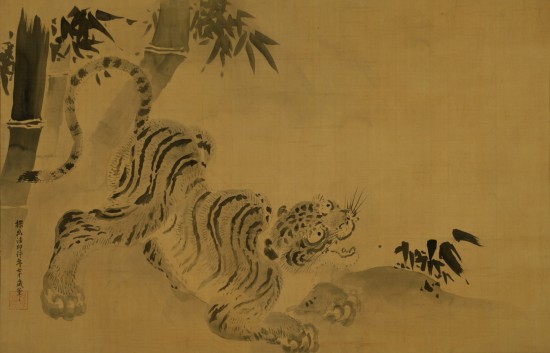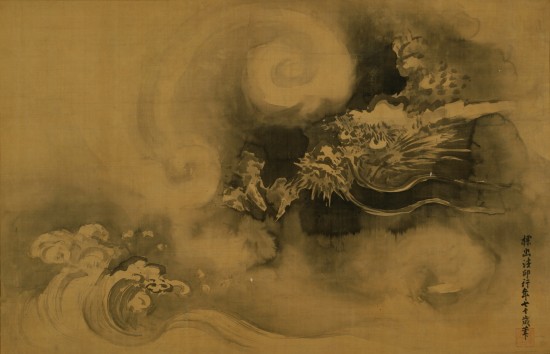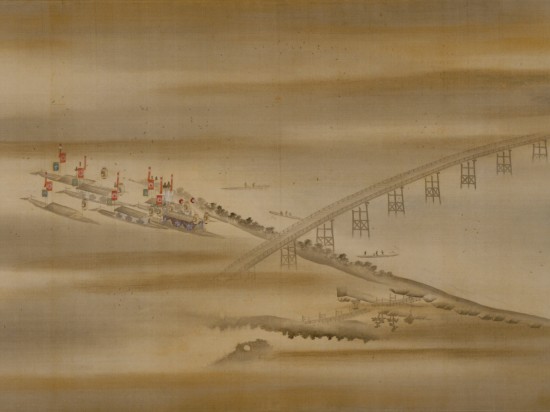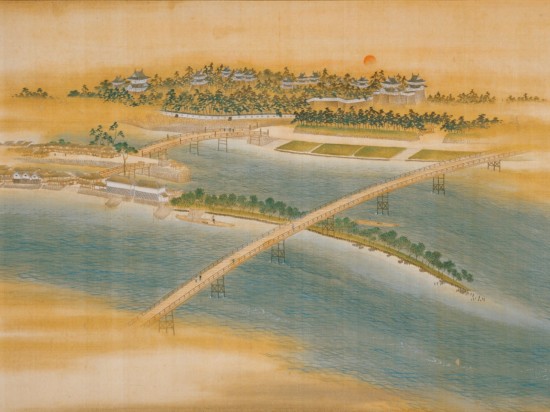from Hara Museum ARC, Gunma
Auspicious symbols for the New Year comprise the theme of Part II of the exhibition Shapes of the Seasons, which began on Friday, December 2 at the Kankai Pavilion, Hara Museum ARC. This show celebrates the New Year season with works that feature long-cherished symbols for longevity, fertility and wealth. These include the crane, tortoise, pine, bamboo and plum. In these paintings, one catches a glimpse of how the Japanese viewed nature, along with the culture and sense of beauty that was nurtured in connection with nature.
On display are masterpieces of Japanese modern paintings from the Hara Rokuro Collection, including Dragon and Tiger by Kano Tan’yu(1602-74), A hundred cranes by Mori Tetsuzan(1775-1841) and Landscape of Yodo River by Maruyama Okyo(1733-95).


Kano Tan’yu, Dragon and tiger, pair of hanging scrolls, Edo period, 1671
In these scroll paintings, a dragon appears in the clouds above waves, while a tiger growls upward at the sky, paws pressed firmly against the earth. In Japan, it was said that the roar of the dragon caused the clouds to gather and rain to fall, and that the roar of a tiger caused the wind to blow. Because they are symbolic manifestations of worldly authority (i.e., heroic figures), they are often depicted facing each and were a much favored subject among military commanders and Zen monks during the Warring States period. India ink bleeding into the paper forms the black cloud and conveys the dynamically changing shape of the cloud, while the swirling clouds and waves express the dynamic motion of the wind.
Also on display is Landscape of Yodo River by Maruyama Okyo (1733-95). Part II shows a section that was not shown in Part I. In this section, the color of the sky changes over time, starting with sundown in the area around Tenmanbashi and ending with sunrise in the area around Osaka Castle.

Tenmanbashi

Osaka Castle
Maruyama Okyo, Landscape of Yodo River, hand scroll (detail), Edo period, 1765
This 16-meter long scroll painting shows the Yodo River as it flows from Fushimi in Kyoto to Tenmabashi in Osaka. The unique perspective by which the scenery unfolds on the top and lower banks, the use of the visual sense to express space, the details of the water surface in ultramarine blue and the accuracy that he achieved through the use of a sketch make this a deeply impressive work of art.
In the last 350 cm of the painting, the color has faded. The depicted images appear only in monochrome ink and gold paint.
Of particular interest is the expression of changes in the sky, clouds and water surface over time.
Selected works of contemporary art also share this space, to enhance your experience of beauty and form.
———————————————–
Shapes of the Seasons
Part II: December 2 (Fri.), 2011 – January 4 (Wed.), 2012
■ Featured works
Traditional Art
Maruyama Okyo, Landscape of Yodo River, Edo period, 1765/Kano Tan’yu, Dragon and Tiger, Edo period, 1671/Mori Tetsuzan, A hundred cranes, Edo period, 19th century/Pair of Satsuma ware sake bottles with portable maki-e case, Edo period, 19th century/Ruyi (Buddhist ritual implement) engraved with human figures, Qing dynasty, 19th century and others
Contemporary Art
David Smith, Tri-Construction, 1941/Anish Kapoor, Void, 1992/Kazz Sasaguchi, constellation, 2002/Noe Aoki, Tateyama, 2007 and others
Place: Hara Museum ARC Kankai Pavilion (traditional East Asian art)
Hours: 9:30 am – 4:30 pm *last entry 30 minutes before closing
Closed: Thursdays (except December 29), January 1
*Subject to temporary closure during severe weather.
Admission: General (over 12) 1,000 yen; children (over 3) 500 yen; 10% discount for a group of 20 or more.
*Children must be accompanied by an adult
**Combination ticket for Hara Museum ARC and Ikaho Green Bokujo ranch: General 1,800 yen; Children 900 yen
Getting There: By train: Take the Joetsu Shinkansen to Takasaki, change to the Joestu Line, and disembark at Shibukawa. From Shibukawa, ARC is 10 minutes away by taxi or 15 minutes by bus (take the Ikaho Onsen bus to “Green Bokujo Mae”). By car: 8 kilometers (about 15 minutes) from the Kan-etsu Expressway Shibukawa Ikaho Interchange (in the direction of Ikaho Onsen).
<website> http://www.haramuseum.or.jp
<mobile site> http://mobile.haramuseum.or.jp
<Twitter> http://twitter.com/#!/HaraMuseumARC
